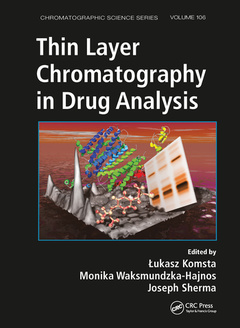Description
Thin Layer Chromatography in Drug Analysis
Chromatographic Science Series
Coordinators: Komsta Lukasz, Waksmundzka-Hajnos Monika, Sherma Joseph
Language: English
Subjects for Thin Layer Chromatography in Drug Analysis:
Keywords
Mobile Phase; Silica Gel 60F-254; Thin-Layer chromatography; Silica Gel Plates; TLC; RF Value; Drug quality; HPTLC Method; Pharmaceutical analysis; TLC Method; Chemical analysis; Sample Preparation; Silica Gel Plates F254; TLC Plate; Tlc Silica Gel; Thin Layer Chromatographic; Stationary Phase; High; Performance Thin Layer Chromatography; Ta Te; RSD; Dragendorff’s Reagent; HPTLC Silica Gel F254 Plate; Tlc Silica Gel F254; Chiral Selective; Silica Gel Tlc Plate; Organic Modier; HPTLC Silica Gel F254; HPTLC Silica Gel Plate
Publication date: 06-2020
· 17.8x25.4 cm · Paperback
Publication date: 02-2014
536 p. · 17.8x25.4 cm · Hardback
Description
/li>Contents
/li>Readership
/li>Biography
/li>
Used routinely in drug control laboratories, forensic laboratories, and as a research tool, thin layer chromatography (TLC) plays an important role in pharmaceutical drug analyses. It requires less complicated or expensive equipment than other techniques, and has the ability to be performed under field conditions. Filling the need for an up-to-date, complete reference, Thin Layer Chromatography in Drug Analysis covers the most important methods in pharmaceutical applications of TLC, namely, analysis of bulk drug material and pharmaceutical formulations, degradation studies, analysis of biological samples, optimization of the separation of drug classes, and lipophilicity estimation.
The book is divided into two parts. Part I is devoted to general topics related to TLC in the context of drug analysis, including the chemical basis of TLC, sample pleparation, the optimization of layers and mobile phases, detection and quantification, analysis of ionic compounds, and separation and analysis of chiral substances. The text addresses the newest advances in TLC instrumentation, two-dimensional TLC, quantification by slit scanning densitometry and image analysis, statistical processing of data, and various detection and identification methods. It also describes the use of TLC for solving a key issue in the drug market?the presence of substandard and counterfeit pharmaceutical products.
Part II provides an in-depth overview of a wide range of TLC applications for separation and analysis of particular drug groups. Each chapter contains an introduction about the structures and medicinal actions of the described substances and a literature review of their TLC analysis. A useful resource for chromatographers, pharmacists, analytical chemists, students, and R&D, clinical, and forensic laboratories, this book can be utilized as a manual, reference, and teaching source.
Part I Theory of Thin Layer Chromatography in Context of Pharmaceutical Analysis. Overview of Drug Analysis and Structure of the Book. Chemistry of Drugs and Its Influence on Retention. Sorbents and Layers Used in Drug Analysis. Optimization of Mobile Phase Composition. Chromatographic Analysis of Ionic Drugs. Ionic Liquid Additives to Mobile Phases. Chromatographic Analysis of Chiral Drugs. Chambers, Sample Application, and New Devices in the Chromatography of Drugs. 2D Planar Chromatography. Quantitative Detection of Drugs by Densitometry and Video Scanning. Statistical Evaluation and Validation of Quantitative Methods of Drug Analysis. Detection and Identification in TLC Drug Analysis. TLC Determination of Drug Lipophilicity. Screening of Substandard and Fake Drugs in Underdeveloped Countries by TLC. Part II Planar Chromatography of Particular Drug Groups. TLC of Antidepressants and Neuroleptics. TLC of Anxiolytics and Sedatives. TLC of Morphine Analogs. TLC of Nonopioid Analgesics, Anti-Inflammatics, and Antimigraine Drugs. TLC of Ergot Alkaloid Derivatives. Thin-Layer Chromatography of Anesthetics. TLC of Psychostimulants. TLC of Antiepileptics. TLC of Alzheimer’s Disease Medicines. TLC of Antiparkinsonians. Thin-Layer Chromatography of Cardiac Drugs. TLC of Antihypertensive and Antihypotensive Drugs. TLC of Beta-Blockers and Beta-Agonists. TLC of Antithrombotics. TLC of Antihyperlipidemics. TLC of Spasmolytics. TLC of Mucolytic, Antitussive, and Antiasthmatic Drugs. TLC of Neuromuscular Blockers. TLC of Antiulcers. TLC of Antiemetic Drugs. TLC of Steroids and Analogs. TLC of Drugs Used in Obesity and Sexual Dysfunction Treatment. TLC of Prostaglandins. TLC of Diuretics. TLC of Antidiabetics. TLC of Antihistamines. TLC of Vitamins Including Nicotinic Acid Derivatives. TLC of Antiseptics. TLC of Sulfonamides. TLC of Quinolones. Thin-Layer Chromatography of Tuberculostatic Drugs. TLC of Antifungal and Antiprotozoal Drugs. TLC of β-Lactam Antibiotics. TLC of Other Antibiotics. Thin-Layer Chromatography of Antiviral Drugs. Thin-Layer Chromatography of Anticancer Drugs. Uncertainty Factors in the Enantioseparation of Chiral Drugs on Silica Gel Layers. Index.
Łukasz Komsta currently serves as assistant professor in the Department of Medicinal Chemistry, Faculty of Pharmacy, Medical University of Lublin, Poland. His research interests include the theory and application of liquid chromatography, especially in connection with computational chemistry and chemometrics, as well as the application of chromatographic methods, especially thin layer chromatography (TLC), in the analysis of drugs. Dr. Komsta is the author or coauthor of more than 80 scientific papers and about 70 scientific conference papers. Since 2011, he has been a member of the editorial board of the journal Acta Chromatographica. He also serves as section editor for the Polish scientific journal Current Issues in Pharmacy and Medical Sciences.
Monika Waksmundzka-Hajnos currently serves as full professor of pharmacy and head of the Department of Inorganic Chemistry at the Faculty of Pharmacy of the Medical University of Lublin, Poland. Her research interests include the theory and application of liquid chromatography, taking into consideration the optimization of chromatographic systems for the separation and quantitation of drugs and their degradation products in pharmaceutical preparations and drugs and their metabolites in body fluids, as well as isolation and/or separation of secondary metabolites in extracts of plant tissues. Professor Waksmundzka-Hajnos is the author or coauthor of about 150 papers, approximately 300 conference papers, and several chapters in known chromatographic textbooks. She is editor of the journal Acta Chromatographica and a member of the editorial board of Journal Planar Chromatography – Modern TLC. Since 2011, she has been a member of the editorial board of The Scientific World Journal—Analytical Chemistry. Professor Waksmundzka-Hajnos is the co-editor of two books from the Chromatographic Science Series: Thin-Layer Chromatography in Phytochemistry (2008,
These books may interest you

Forced-Flow Layer Chromatography 182.55 €



